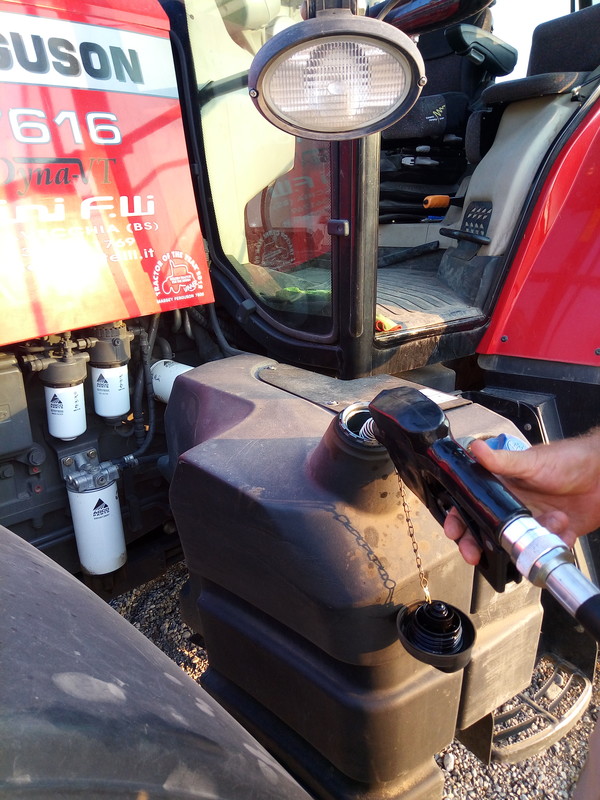
Diesel Fuel Filters and Operating Oils
Of the many filters used on the tractor, those of diesel fuel and operating oils certainly play an essential role in ensuring proper operation and little wear over time of the mechanical parts involved
The need to use fuel with a high degree of cleanliness is an essential requirement above all for the latest engines, in which diesel fuel is pulverized at pressures of a few hundred bar. This is an even more urgent requirement for engines equipped with common-rail, in which the injected diesel reaches pressures even higher than 2,000 bar, with more injections per cycle. As a result, in order to ensure an extremely high degree of atomization, the injector nozzles must be of tiny diameter (diesel fuel is in fact sprayed in droplets with a diameter between 20 and 100 microns), a feature that raises the risk of occlusion if there are impurities and/or water in the diesel fuel. This requires careful attention, as the bottom of the farm tanks often contains both sludge (a mixture of rust, algae, dust) and condensation water, which can accidentally be introduced into the tractor tank when refueling.
Even prolonged vehicle stops can result in condensation inside the tank, especially if the tractor is shut-down with little diesel fuel (this is why the manufacturers suggest storing the tractor with a full tank). Therefore, in order to avoid engine starting difficulties due to polluted diesel fuel and to avoid sudden drops in tractor power while working, it is essential to take care of both the quality of the fuel and the maintenance of its filter. If the instructions on this matter given in the Operation and Maintenance Manual are not strictly applied, this may result in much more severe problems than those illustrated, i.e., significant issues with the injection pump and the injectors, requiring costly overhauls or even the substitution of damaged components.
The degree of diesel filtration required in diesel engines powering agricultural machinery is between 10 microns for the less "demanding" engines and 1 micron for those of the latest generation. In the first case, this filtering capacity is ensured by cellulose filters with the addition of a special resin coating while, in the second case, the filtering material is usually made up of synthetic fibers adequately arranged to ensure adequate retention of impurities and prevent the passage of water. The diesel fuel coming from the feed pump enters at low pressure from a series of holes arranged in a circular crown at the top of the filter, crosses it from top to bottom and, cleaned of water and impurities, flows back into a central channel and then is sucked by the injection pump.
Filters with basal tank and non-replaceable upper part
In this case, when replacing the filter, it is necessary to make sure that the filter is correctly positioned between the tray and the support, as the corresponding gaskets ensure its sealing. It is also essential to pay attention to the gaskets sealing on the fixing screws, one of which is for the inlet of the diesel fuel coming from the tank and the other for the outlet to the injection pump. If these seals are loosened, they must be replaced, as they are no longer able to provide the necessary seal, being made of soft metal.
Independent cartridge filters
The gaskets are already embedded in the cartridge, therefore no particular precautions are required for their installation, except for a little lubrication to guarantee their holding.
Both types of filters have a small basal tank for condensate water storage, which can be emptied through a small drain valve. Some tractors have a glass pre-filter, placed above the actual filter, in which there is an additional metal mesh filter element and in which the decanting water is stored, thanks to the different volume mass of the two liquids. Through the opening of a special clamping screw, it is possible to empty this bowl of accumulated water from the coarsest impurities contained in the diesel fuel.
In most modern tractors, there may be sensors for monitoring both the fuel characteristics and the possible water presence in the bottom of the filter. Furthermore, particularly in machinery designed to operate in cold climates, there may be a small heating circuit of the filter element: this considerably simplifies cold starts, as the separation and precipitation of the paraffin in the diesel fuel is prevented.
Needless to say, filters also need to be regularly replaced: as a general rule, manufacturers suggest changing the diesel fuel filter every 600 working hours.
Operating Olis Filters
These filters are required to ensure adequate retention of impurities, even the smallest ones, which can mix with the different types of oil (hydraulic system, transmission, lift, steering) without causing excessive resistance to the passage of fluid flow. In agricultural tractors, pollutants are commonly represented by metal particles detaching from mechanical components (e.g. gears) due to friction caused by their movement. These impurities usually have a 5 to 60 micron diameter, and if not intercepted, may cause wear in the seal rings over time. This is a serious problem, considering the high working pressures that can be reached: In tractors, the maximum operating values of the hydraulic system of lifting gear and spool valves can be as high as 200 bar, while in the hydrostatic component of a modern, continuously variable transmission, the maximum operating values can exceed 600 bar.
As a general rule, the filtering material is made up of cellulose fibers arranged randomly to form a structure that is often soaked with special resins to offer longer life and filtration efficiency. Synthetic fibers are often adopted as an alternative to cellulose fibers, arranged in multilayers with different densities. However, more recently, a structure is spreading combining these two materials, thus matching the natural fiber's filtering capacity with the mechanical strength and chemical resistance of the synthetic fiber.
Immersion filters
They include a filter cartridge, placed in a special cup housing fixed on the machine body. The filter is sealed by an O-ring type gasket, which is replaced when the filter is changed. The by-pass valve, placed at the top of the cup housing (and therefore of the filter), which is essential to ensure a constant oil flow in all conditions, is never replaced in this type of filter.
Cartridge Filters
They consist of a metal container inside which the filter element and the by-pass valve are set. Therefore, the by-pass valve is automatically replaced when the filter is changed. Usually, in agricultural vehicles, the operating oil filters are replaced when the lubricant is changed, i.e. between 600 hours, in the case of low power tractors, and 1200-1500 hours, for all the others.
Compared to the immersion filter, which is certainly simpler and cheaper, thanks to the metal casing that helps heat dissipation and consequently protects the element, the spin-on oil filter is usually more resistant to high temperatures and pressures, conditions that increasingly occur in modern engines. Furthermore, the chance to replace at every filter change also the related by-pass valve ensures the hydraulic system optimal working conditions even in the case of filter clogging. This is not always possible with the immersion filter in which the by-pass valve, being an integral part of the socket housing fixed to the machine body, can be subject to possible malfunctions over time.








